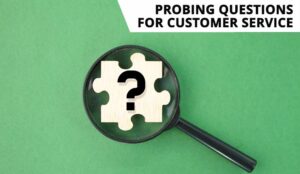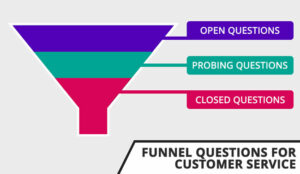Understanding the customer is a critical step towards solving problems and delivering exceptional service in your call centre.
However, getting to the heart of an issue can take a lot of time—unless you know how to use probing questions effectively.
With this approach to customer service questions, you can unlock any conversation and get to a solution quicker.
This is a vital aspect of CX, as according to Salesforce, 83% of customers expect a resolution at the first attempt.
Call centre probing questions don’t just help agents gather information and keep their average handle time down, they keep the customer engaged throughout the conversation and make them feel valued, improving loyalty and retention.
Shane Croghan at Scorebuddy looks at the key benefits, some common examples, and how you can use these questions effectively in your contact centre.
What Are Probing Questions in a Call Centre Environment?
Probing questions are a way to gain greater insight into the needs, emotions, and reasons behind a customer’s words.
They’re a form of troubleshooting you can apply to better understand the customer’s query and their desired outcome.
The aim of these questions is to gather information and identify customer concerns so you can deliver a personalized solution.
This style of questioning also offers an opportunity to show genuine empathy and build stronger relationships with customers.
Probing questions don’t just make things easier for the agent, they simplify the process for customers too.
Some may have difficulty explaining their issue, and these questions help them go beyond a simple yes/no response.
While probing questions are particularly useful if you’re unsure of what the customer wants, they should be a regular feature of any call.
For best results, you should implement this technique as part of your established call centre processes and workflows.
What Are the Benefits of Using Probing Questions?
With probing questions, you can determine the facts of a situation and find out exactly how the customer feels.
This allows you to deliver a tailored solution based on their unique needs, improving the customer experience and giving you a clear objective right away.
A better experience boosts customer satisfaction scores and helps to build trusting relationships, leading to increased loyalty and retention.
In fact, according to Zendesk, 70% of customers feel more loyal to a company that offers a personalized experience.
By asking the right questions, rather than making assumptions, you can get a full picture of the problem and assist the customer more efficiently.
This improves first call resolution (FCR) rates and average handle time (AHT) without sacrificing CSAT scores.
The Most Effective Probing Questions You Should Try
The best probing questions are open-ended and neutral. You don’t want to guide the customer unintentionally with leading questions that might sway their response.
Let’s look at some examples of the most useful probing questions for different aims.
Identifying the Root Cause of the Problem
To solve a problem effectively, you need to dig deep and find out what’s causing it. Here are some probing questions you can try.
When Did This Situation/Issue First Occur?
If you know how long an issue has been happening, you can better understand the customer’s level of frustration and the urgency of finding a solution.
The answer can also influence your next steps, with a longer-term issue often implying the need for a bigger fix.
Is This a Recurring Problem, or Is It the First Time You’ve Encountered It?
It’s helpful to know if it’s a one-off or a frequent issue. If it has happened before, you can find out how it got resolved last time, potentially informing your approach this time.
You may also be able to suggest adjustments that will prevent another occurrence in the future.
Could You Describe What You Were Doing Before the Issue Occurred?
Be careful here. You don’t want to sound accusatory, but you do need to find out if the customer caused the issue by accident.
If they did, it’s important that you know what they were doing at the time, as this could help identify the cause and find an appropriate, timely solution.
Have You Already Taken Any Steps to Try and Resolve the Issue? If So, What Have You Tried?
You don’t want to add to the customer’s frustration by suggesting things they’ve already tried, so it’s important to clear that up.
You should also follow up with a funneling question and ask what they tried and what issues they ran into.
Just to Make Sure That I Fully Understand the Issue, Could You Give Me an Example of What You Mean by [Insert Issue]?
Asking for an example can help the customer articulate the problem and make it easier for you to visualize it. Their answer can help you home in on the specifics of the issue as you search for a solution.
Assessing Customer’s Feelings
Delivering a positive customer experience is about addressing emotional needs as well as technical issues. These questions will help with the former.
What Impact Has This Issue Had on Your Business/Operations/Day-to-Day?
The customer’s answer here will give you a sense of their priorities and business concerns, as well as their level of frustration and the gravity of the issue.
Once you understand the day-to-day impact, you can better customize your response to target affected areas quickly.
Has [Insert Issue] Caused Any Other Problems for You?
The impact of the issue may be more far-reaching than you first imagined. With this question, you can assess the scale of the problem and gain insight into the cause.
Additionally, you’ll get a sense of the customer’s emotional state, giving you a chance to apologize sincerely and show empathy.
Do You Have Any Worries or Concerns About Implementing [Insert the Suggested Solution]?
If you’re not sure how the customer feels about your proposed solution, it’s better to ask outright and give them a chance to air any concerns. This gives you the opportunity to reassure them and clear up any misunderstanding.
Driving Action
At the end of the day, customers want a resolution above all else, so it’s important that you continue to drive the conversation forward. These questions will help you keep things moving.
What Is Your Ideal Outcome From the Call Today?
By asking this straight out, you can quickly get a sense of the customer’s expectations. Once you’ve defined these expectations, you’ll be able to adjust your approach accordingly, find a satisfactory outcome, and avoid repeat calls.
Is There a Timeframe That You’d Like Us to Work Within to Resolve This Issue?
Again, this is about defining and managing customer expectations. While many will request a solution ASAP, you should be able to discern which issues are truly time-sensitive.
For example, getting an e-commerce website back online ahead of a big product launch is more urgent than a single customer requesting a return label.
Is There Anything Else I Can Help You With Today?
This is especially useful at the end of a call. It gives the customer a chance to bring up anything you missed, ensuring that you have all the information you need to deliver a satisfying resolution. It’s the call centre equivalent of Columbo’s “Just one more thing…”
Best Strategies to Improve Probing Questions in Your Call Centre
Of course, it’s not enough to just throw a list of probing questions at your customers. You need to work them into the conversation naturally. Let’s look at some ways you can improve the quality of your call centre probing questions.
Show Genuine Interest
Just as you can read a customer’s tone, they can read yours. If you’re being insincere, they will pick up on it and customer satisfaction scores will plummet.
Showing genuine interest builds trust and helps you pick out the best moments to ask probing questions.
Personalize the interaction by using the customer’s name regularly, and use your CRM to record details about them.
Also, never interrupt or cut across, or they’ll feel like you don’t care. Allowing them time to share their ideas will make them feel valued, while also giving you a better understanding of the issue.
Use Active Listening
Without strong communication skills, it’s difficult to use probing questions effectively. By listening carefully to the customer’s tone and word selection, you can further showcase your genuine interest and have an honest, authentic interaction.
Pay attention to what the customer says and how they say it, as well as the things they don’t say.
Use clarifying questions to emphasize the fact that you’re listening and further drill down to the root cause of the problem with probing questions.
Empathize With Your Customers
Empathy is about putting yourself in the customer’s shoes to understand how they’re feeling and why they’re feeling that way. It allows you to find the emotions behind the facts. To do it right, you’ll need soft skills like emotional intelligence, enthusiasm, and attentiveness.
You’ll have to acknowledge feelings, validate concerns, and show your support. Empathy statements are particularly useful here.
For example, you could say, “I’m so sorry to hear about this”, or “I would feel the same in your situation.”
Make sure you’re genuine and really mean it, though. Otherwise, these statements could backfire.
Never Lose Patience
Prioritize patience, even if you’re struggling to find answers or the conversation becomes frustrating.
Average handle time is a popular call centre metric, but it shouldn’t come at the cost of lower customer satisfaction. Taking your time to find the right solution is important.
If you lose patience and begin to rush it, the customer may feel like you’re blaming them for the issue—and you never want that.
Embrace listening and give them time to air all of their concerns. The more you listen, the better equipped you are to deliver a tailored solution.
Try to Avoid Asking ‘Why’
On a similar note, asking ‘why’ can come across as judgmental and put the customer on the spot.
This could put them in a defensive mindset, making it much more difficult to build a rapport and find the right solution.
In practical terms, ‘why’ questions are too broad and difficult to answer. It’s better to be specific and use probing questions.
If you must ask a ‘why’ question, avoid using the word itself. Instead, use phrasing like “Just to confirm the details…” or “To circle back…”
Consider Using an Open-Probing-Closed Question Funnel
The open-probing-closed approach, sometimes known as the funnel effect, is a guideline you can use to keep the conversation flowing in the right direction. While it isn’t always appropriate, it can provide a basis for your questioning.
You start with an open-ended question so the customer can explain the problem. You then pick out key points from their answer and dig a little deeper with a probing question.
Finally, you use a closed question to confirm that you understood correctly and clarify the next steps.
Make Sure You Address All of the Customer’s Concerns
Our final example from earlier, “Is there anything else I can help you with today?” is one of the most important probing questions in your arsenal. With this question, you can be sure you’re addressing all of the customer’s concerns.
By leaving no stone unturned, you’ll be able to minimize repeat calls and boost your FCR rate. This is essential to contact centre success, as even a 1% improvement in first call resolution can lower operating costs by 1%.
Make Probing Questions Part of Your Training
Including probing questions in agent training is essential if you want the best results. With call monitoring and recording, as well as QA tools like scorecards and conversational analytics, you can pinpoint weak spots and identify agents who require further training.
Once you know what areas you need to target, you can employ training methods like workshops, role playing, and one-on-one coaching sessions.
With advanced QA tools like conversational analytics and integrated business intelligence, you can even have AI automatically review and mark up past interactions for you.
Practice Makes Perfect
Using probing questions is like any other skill—the more you practice, the better you get. The training methods mentioned above are useful, of course, but there’s nothing quite like the real thing.
Get your agents to use these questions during real calls, review the recording, and give constructive feedback while the interaction is still fresh.
You can also encourage reps to share their experiences and even add probing questions guidelines to your knowledge base.
Conclusion
If you don’t understand your customers, it’s difficult to deliver exceptional service. With probing questions, you can really dig into the heart of the matter and develop a clear picture of customer requirements, as well as their emotional needs and desired outcomes.
This level of insight allows your agents to not only find solutions quicker, but personalize them for each customer, driving stronger performance for key call centre metrics like first call resolution, average handle time, and CSAT.
By following the examples and strategies we’ve outlined above, you can make these questions an integral part of your playbook and reap the rewards of improved customer retention and loyalty.
This blog post has been re-published by kind permission of Scorebuddy – View the Original Article
For more information about Scorebuddy - visit the Scorebuddy Website
Call Centre Helper is not responsible for the content of these guest blog posts. The opinions expressed in this article are those of the author, and do not necessarily reflect those of Call Centre Helper.
Author: Scorebuddy
Published On: 18th Dec 2023 - Last modified: 9th Dec 2024
Read more about - Guest Blogs, Scorebuddy






 Scorebuddy is quality assurance solution for scoring customer service calls, emails and web chat. It is a dedicated, stand-alone staff scoring system based in the cloud, requiring no integration.
Scorebuddy is quality assurance solution for scoring customer service calls, emails and web chat. It is a dedicated, stand-alone staff scoring system based in the cloud, requiring no integration. 









